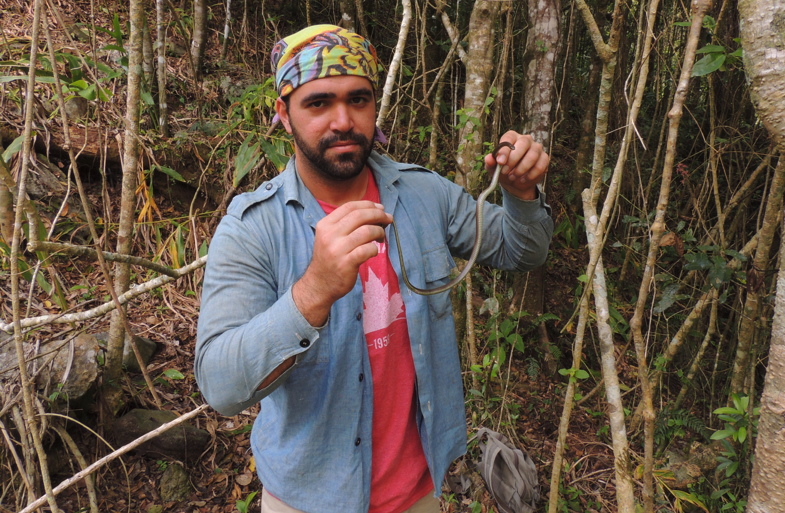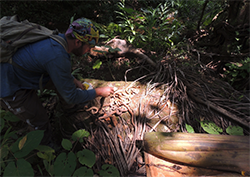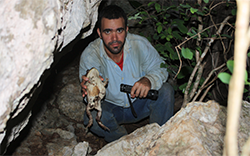Cuban researcher comes to study for doctorate in Kansas, bringing along important herpetology collection

LAWRENCE — Growing up around Havana, Javier Torres López always was fascinated by reptiles. As the son of a professor who teaches vertebrate zoology at the University of Havana, he focused on studies of literature and science in high school and thought about following in his father’s footsteps.
 “In Cuba, everyone has an opportunity to go to university,” he said. “You have to take tests according to your preferred major, and you have the right to pick up to 10 majors. Based on the tests results and your high school score, you get one of the 10 options. I was able to obtain my first choice, biology. So, I started studying at the University of Havana as a biology major — that was in 2004. There, for the first time, I started to become aware of the diversity of Cuban and Caribbean amphibians and reptiles.”
“In Cuba, everyone has an opportunity to go to university,” he said. “You have to take tests according to your preferred major, and you have the right to pick up to 10 majors. Based on the tests results and your high school score, you get one of the 10 options. I was able to obtain my first choice, biology. So, I started studying at the University of Havana as a biology major — that was in 2004. There, for the first time, I started to become aware of the diversity of Cuban and Caribbean amphibians and reptiles.”
As an undergraduate, Torres started conducting original research, finding himself drawn to Tropidophis, a genus of dwarf boa snakes endemic to the Caribbean and South America.
“I was totally into studying snakes,” Torres said. “I found out about this particular group of Cuban snakes called dwarf boas. Studying the behavior of those snakes got me a ticket to the Latin American Herpetology Congress held in Cuba in 2008.”
 There, Torres had his first contact with Rich Glor, KU associate professor of ecology & evolutionary biology and associate curator at KU’s Biodiversity Institute. The two stayed in contact over the years as Torres completed his undergraduate studies. All the while, Torres continued to investigate species endemic to Cuba, spending time in the field and learning important lessons about research.
There, Torres had his first contact with Rich Glor, KU associate professor of ecology & evolutionary biology and associate curator at KU’s Biodiversity Institute. The two stayed in contact over the years as Torres completed his undergraduate studies. All the while, Torres continued to investigate species endemic to Cuba, spending time in the field and learning important lessons about research.
“After a while studying the behavior and biology of dwarf boas, I understood it was a difficult system to work with because they are quite rare and hard to find,” Torres said. “So, I started to work on a project to understand the distribution of diversity depending on the landscape. On this project, I started to study anoles, a group of diurnal lizards highly diversified in Cuba. It’s the richest island when we talk about anoles. In contrast to dwarf boas, they’re quite common, and you can find enough individuals to let you answer questions in ecology, evolution and conservation.”
Researching Cuban anoles, Torres earned his master’s degree by studying the consequences of hybridization among different anole species. He also spent several years teaching zoology and herpetology as an instructor at the University of Havana. While he contemplated earning a doctorate, he kept in touch with Glor at KU.
“While working on my master’s, I was reading Rich’s papers, and I really liked that our interests were alike,” Torres said. “So, I wrote to him and we started to exchange information. I came to the U.S., and he came to Cuba. Finally, I applied here and I am following Ph.D. studies in the same vein as my master’s, with a side project on Tropidophis.”
Now at KU, Torres holds his Cuban citizenship and makes return visits to his home island.
He maintains strong ties with his professional colleagues in Cuba, where he continues to advise students at the University of Havana. He also recently submitted a grant to National Geographic to fund several major field expeditions back to Cuba.
Indeed, Torres is already making vital contributions to herpetological research at KU. He has donated a major collection of tissue samples of reptile species endemic to Cuba to KU’s Biodiversity Institute. The valuable material can be used by current and future researchers interested in Cuban and Caribbean herpetology.
“When I traveled here to start my Ph.D., I brought 400 tissue samples of Cuban reptiles, and last month I went home to Cuba and brought back about 600 more samples — now the Biodiversity Institute has about 1,000 samples of 63 Cuban species, mostly reptiles, and most of them are endemic,” Torres said. “I would say the KU Biodiversity Institute harbors one of the most important tissue collections of Cuban reptiles. A tissue sample is the raw material for conducting genetic studies. There is a lot of things you can do with genetics, but there is a major concern in evolutionary biology which genetics allows us to understand better — how and why new species arise. From that number of samples, you can think of several projects involving the study of the DNA.”
Moreover, Torres and Glor traveled this summer to Cuba, where they worked on preparation of 760 whole specimens for eventual transport to KU. “The plan is to bring those back the next time I travel to Cuba,” Torres said.
“This will be the most important collection of Cuban reptiles brought to the United States in the past 20 years and includes lots of rare Cuban endemics,” Glor said.
Studying in the U.S. has some major advantages over the choices and technologies made available at Cuban universities, according to Torres.
“Here, it is easier to build your preferred curriculum because there are more options of classes — in Cuba, you have more mandatory and less optional classes. But the largest difference is in the area of resources. In Cuba, we have a great theoretical program, but when you have to do labwork, we don’t have all necessary tools and equipment and we have to search for alternatives. So basically, here there’s better availability of textbooks, journals, internet and technology.
“I feel very pleased and very lucky to be here in at the Biodiversity Institute,” he said. “Particularly the herpetology division here at KU is a great group to be with. For me, the first months were tough, but thanks to the help I found in my adviser, fellow students and other researchers at the herpetology division (and the BI in general) I made it through.”
That said, Torres finds himself missing many of the most important aspects of home. Most of all, Torres misses his family and girlfriend. “I don’t have to think about answering that,” he said.
But he also finds himself craving Cuban home cooking.
“I’m planning to go home in December to spend New Year’s Eve in Cuba,” Torres said. “It is a tradition in there to spend it with family eating roast pork, rice, beans, yucca, fried plantain and salad. I love this town, but Cuban cuisine is different from what you find in Lawrence. I don’t think there’s an authentic Cuban restaurant. I had a Cuban sandwich here — it was very good, but it wasn’t Cuban.”
Photos (courtesy of Javier Torres López ):
At top: Javier Torres López shows a putative new snake species, which lives in the mountains of central Cuba.
Top right: Relocating a group of giant tropes (Tropidophis melanurus) found in a risky area.
Bottom right: The largest toad in Cuba, Peltophryne fustiger, is quite common in the west.